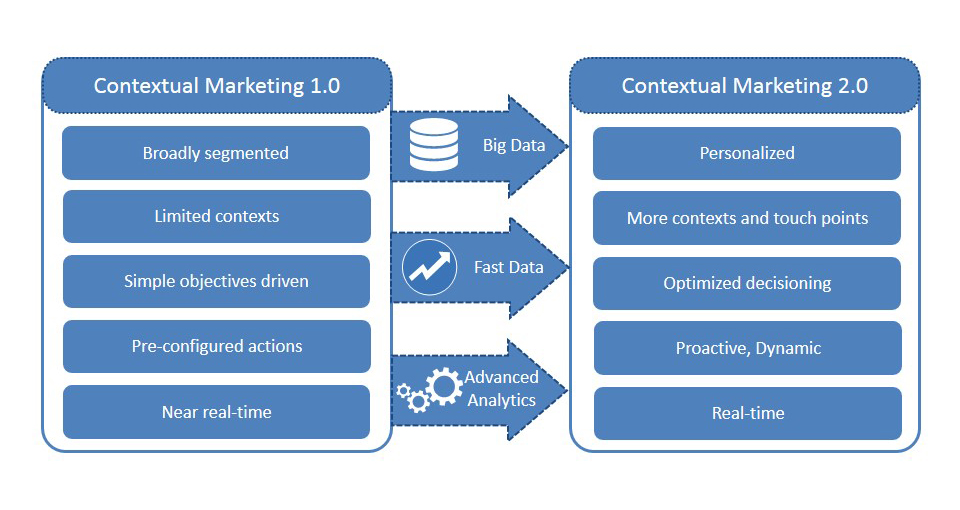The biggest challenge Communication Service Providers (CSPs) or Telcos face today is how to keep their customer base intact in this volatile and competitive environment. Contextual marketing has emerged as a popular customer engagement tool for Telcos. However the scope and definition of contextual marketing has changed over the years. There are many prerequisites to running a successful contextual customer engagement program, the key ones being the ability to have a deeper understanding of the subscriber all the time and initiating the right action at the right time to make the desired impact. With time, more dimensions are being added to contextual marketing, especially with big data, fast data and advanced analytics coming into the mainstream.
How contextual marketing programs fall short of customer expectations
In the early days of contextual marketing, the focus was just on initiating the action. Telcos with traditional marketing systems could only do broader segmentation, define limited contexts and also pre-configure required offers and actions for different segments in different contexts. In a nutshell, contextual marketing programs were mostly pre-defined and unidirectional.
Certainly it was much better than no action at all and held some promise of value. For example, programs were limited to identifying limited contexts like usage falling below a threshold value and sending an upsell pack offer to high-value and medium-value customer segments.
Over a period of time CSPs understood that, although there were improved responses and conversions, contextual marketing programs did not achieve the desired long-term impact. Conversions slowly declined, eroding margins.
If we analyze the first series of contextual marketing programs, we can definitely see the shortcomings, as follows:
- Not all data is considered while doing segmentation. This prevents the CSP from having an in-depth understanding of the subscribers for micro-segmentation. With broader segmentation, always a hit-and-miss game, offers/actions may not be relevant to all subscribers within a segment. For example, if data usage is not considered and a program is just run on value-based segmentation, then marketers may end up sending voice packs to high-value data users, which may upset them.
- Historic data is not enough to determine what a customer needs in a particular context. Today’s subscribers are dynamic in nature; their needs and preferences change rapidly from one context to another. Location is one such data point. For example, if a subscriber is on roaming, he would not be happy to receive a data upsell offer.
- Today subscribers interact over many touch points. Contexts also multiplied by leaps and bounds as subscribers started using different types of products and services. Voice, data, video, mobile apps, social media, etc. present many contexts of use, which need to be tapped for engagement with subscribers.
- Context is not just the right time or a specific event; context has more dimensions in the current business environment such as channel, location etc. All these dimensions need to be analyzed to determine the right context for initiating the right action for any subscriber.
- Rule-based offers limit the capability to remain proactive and dynamic when it comes to meeting the contextual needs as well as responding to customer responses at different touch points.
Enter big data, fast data and advanced analytics
With the advent of big data, fast data and advanced analytics, contextual marketing has assumed a whole new level of sophistication. With big data integration and advanced analytics models, it is now possible to deep-dive into varied data sources and analyze any and all possible data to construct a 360-degree view of each subscriber. Such an in-depth view helps in creating an accurate behavioral persona as well as the usual patterns in the user’s needs and preferences.
Streaming data or fast data, which brings real-time data such as location and network into action, helps in discovering current contexts that are very short lived or have a very small window of opportunity for capitalization.
In one of Flytxt’s deployments, millions of such triggers are generated from billions of events every day which, in turn, are used for contextual engagement with customers. Advanced analytics thus can provide CSPs with insights on a subscriber’s historic persona, current context and even predicted needs of the future. This combination provides a holistic view of a subscriber that is then used to design the right marketing action at the right time with a high level of accuracy.

Source: Flytxt
Advanced analytics are not used just for designing marketing actions based on a subscriber’s context, persona and needs; it can also optimize actions and decisions to meet a CSP’s business objectives. For example, the CSP needs to ensure that it extends the most appropriate offers so as to meet revenue and margin targets.
In a way, big data and advanced analytics complement fast data and real-time analytics; the former identify and recommend the right marketing action while the latter inform the right time and context to execute that action for optimal results.
It’s time to embrace contextual marketing 2.0
As subscribers demand more and more with evolving needs and preferences, it is time for CSPs to embrace contextual marketing 2.0 in order to stay relevant to them. Unless marketing actions are proactive by anticipating a subscriber’s needs and is dynamic to change according to the subscriber’s changing context and preferences, the marketing action risks being superfluous communication.
Contextual marketing 2.0 addresses these challenges and enables creating highly personalized and timely communication that appeals to subscribers’ unique needs. Above all, contextual marketing 2.0 is real time, as no communication is effective if it is not done within the window of relevance.
Pravin Vijay is director-marketing at Flytxt. He is an avid technology marketer with 12 years of experience working with software product companies in the Telecom and Banking domains. He manages global marketing initiatives of Flytxt, a fast-growing big data analytics technology company with a focus on enabling mobile operators to generate measurable economic value from data available with them.
